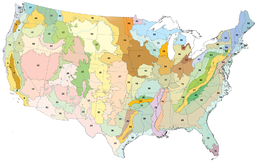Northern mixed grasslands
| Northern mixed grasslands | |
|---|---|

Northern mixed grasslands (area 46 on the map)
|
|
| Ecology | |
| Realm | Nearctic |
| Biome | Temperate grasslands, savannas, and shrublands |
| Borders |
|
| Bird species | ? |
| Mammal species | ? |
| Geography | |
| Country | United States, Canada |
| States/Provinces | North Dakota, South Dakota, Minnesota, Saskatchewan, Manitoba |
| Conservation | |
| Habitat loss | 75% |
| Protected | Very low% |
The Northern Mixed Grasslands is one of 867 terrestrial ecoregions defined by the World Wide Fund for Nature. This ecoregion includes parts of the Canadian provinces of Saskatchewan and Manitoba, north-central and eastern (except extreme eastern) North Dakota, most of east South Dakota, and small portions of western Minnesota in the American Great Plains. The United States Environmental Protection Agency (EPA) defines this ecoregion as the Northern Glaciated Plains.
This is a transition zone between the ecoregions of the Northern tall grasslands to the east and the Northern short grasslands to the west, while to the north lie the cooler Canadian boreal forests and a much shorter growing season.
The Mixed Grass prairie was recognized as a mixture of the tallgrass and shortgrass prairies. The dominant grasses found here include grama (Bouteloua gracilis), little bluestem (Schizachyrium scoparium), needle-and-thread grass (Stipa comata), wheatgrass (Agropyron smithii), Carex filifolia, junegrass (Koeleria cristata), and Poa secunda.
...
Wikipedia
